
Choosing the right lithium battery for smart doorbell systems directly affects your home security, device reliability, and uninterrupted wi-fi connectivity. Industry reports show that a high-quality doorbell battery with proper capacity, weather resistance, and built-in safety features ensures stable power, longer battery life, and continuous operation. When evaluating factors to consider when choosing doorbell batteries, always prioritize compatibility, voltage, and reputable brands to prevent power loss and maintain wi-fi-enabled security monitoring. Selecting a rechargeable battery with the correct specifications reduces downtime and keeps your doorbell battery performing at its best.
Key Takeaways
Always match the battery voltage and size to your smart doorbell’s original specifications to avoid device damage and ensure reliable power.
Choose high-quality lithium-ion or lithium-polymer batteries from reputable brands that offer safety features and long battery life.
Protect your doorbell battery from extreme weather by installing it in shaded areas and following maintenance tips to extend its lifespan.
Part 1: Choosing a Lithium Battery for Smart Doorbell
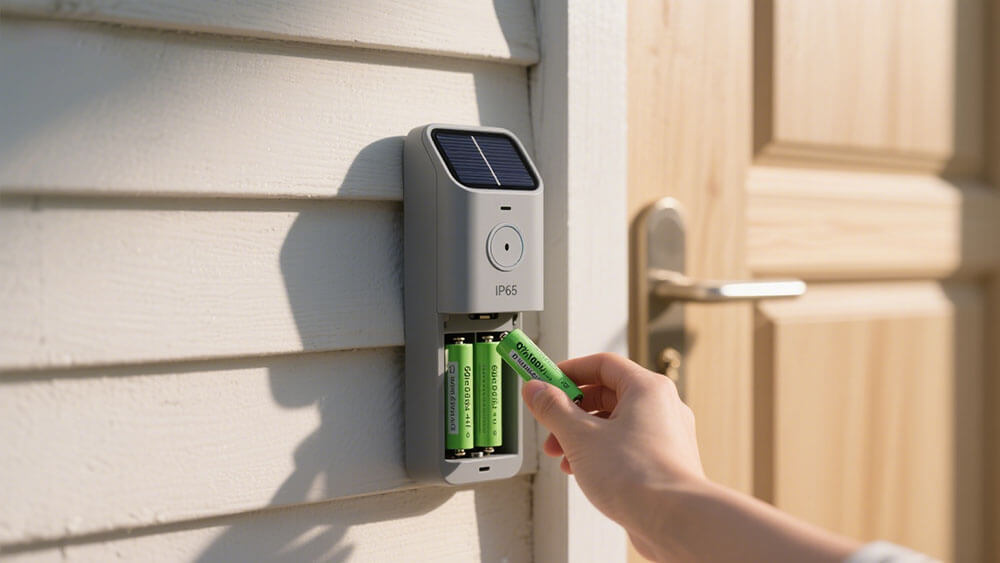
1.1 Voltage and Compatibility
Selecting the correct voltage stands as the most critical factor when choosing a lithium battery for smart doorbell systems. Most wireless doorbells require a single-cell lithium battery with a nominal voltage of 3.7V and a fully charged voltage of 4.2V. Wired models, on the other hand, often operate within a higher AC voltage range, as shown in the table below:
Smart Doorbell Model | Voltage Requirement (AC) | Frequency | Notes |
|---|---|---|---|
Ring Video Doorbell Wired | 8 to 24 V AC | 50/60 Hz | Common wired model voltage range |
Ring Pro and Pro 2 | 16 to 24 V AC | 50/60 Hz | Narrower voltage range for Pro models |
SimpliSafe Video Doorbell | 8 to 24 V AC | 50/60 Hz | Compatible with existing wiring |
Nutone Doorbell | 10 to 24 V AC | N/A | Ideal transformer voltage is 16 V AC |
Reolink Wired Doorbell | 12 to 24 V AC or 24 V DC | 50/60 Hz | Supports AC or DC input |
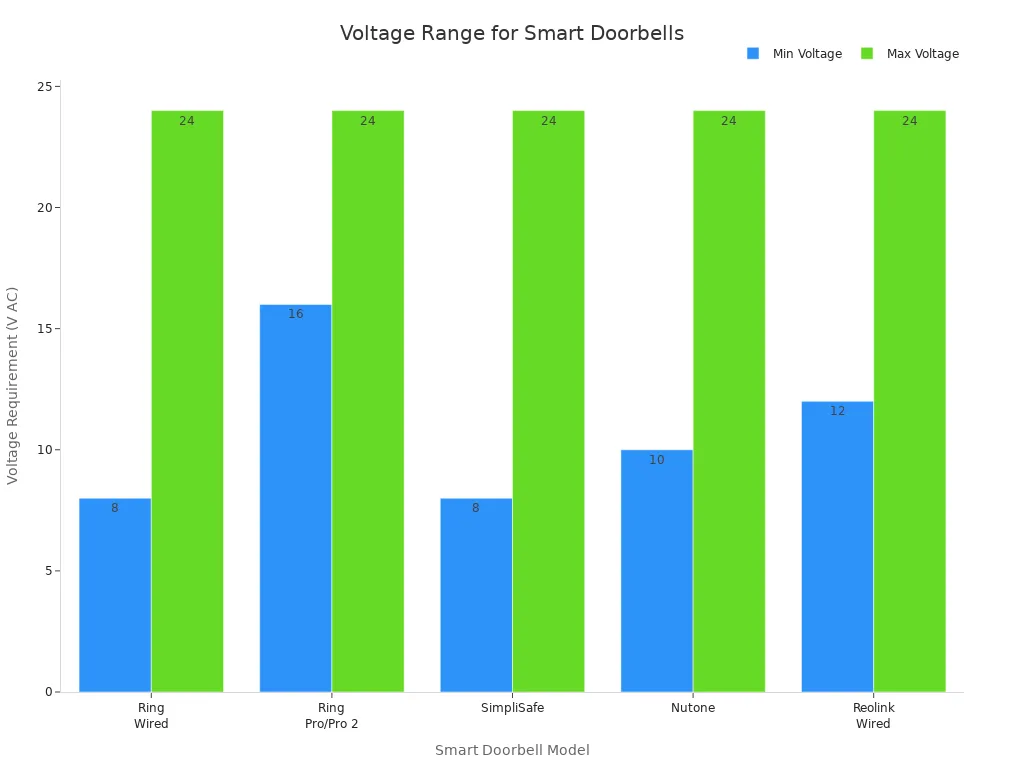
You must always match the voltage of your new doorbell battery to the original specifications. Using a battery with the wrong voltage can cause your device to malfunction, lose power, or even suffer permanent damage. For example, a battery with too low a voltage may result in weak chimes, delayed responses, or loss of wi-fi connectivity. Too high a voltage can overwhelm the system and create safety hazards. Always check the original battery label, user manual, or manufacturer’s website before purchasing a replacement.
Tip: Never guess the voltage. Confirm compatibility with your smart doorbell’s requirements to ensure reliable power and maintain home security.
1.2 Capacity and Runtime
Battery capacity, measured in milliampere-hours (mAh), directly impacts how long your doorbell battery will last between charges. Most lithium batteries for smart doorbells fall within the 2600mAh to 6500mAh range. The table below highlights typical capacities for different components:
Component Type | Battery Capacity Range (mAh) | Example Models and Capacities |
|---|---|---|
Camera Host Units | 2200 – 6500 | Ring Video Doorbell 3/4 (6040mAh), Eufy 2K (6500mAh), Arlo Essential (2200mAh) |
Button Units/Sensors | ~160 | Typical lithium polymer cell for buttons |
18650 Li-ion Cells | 2600 – 3600 | Used in video doorbells for stable voltage and long cycle life |
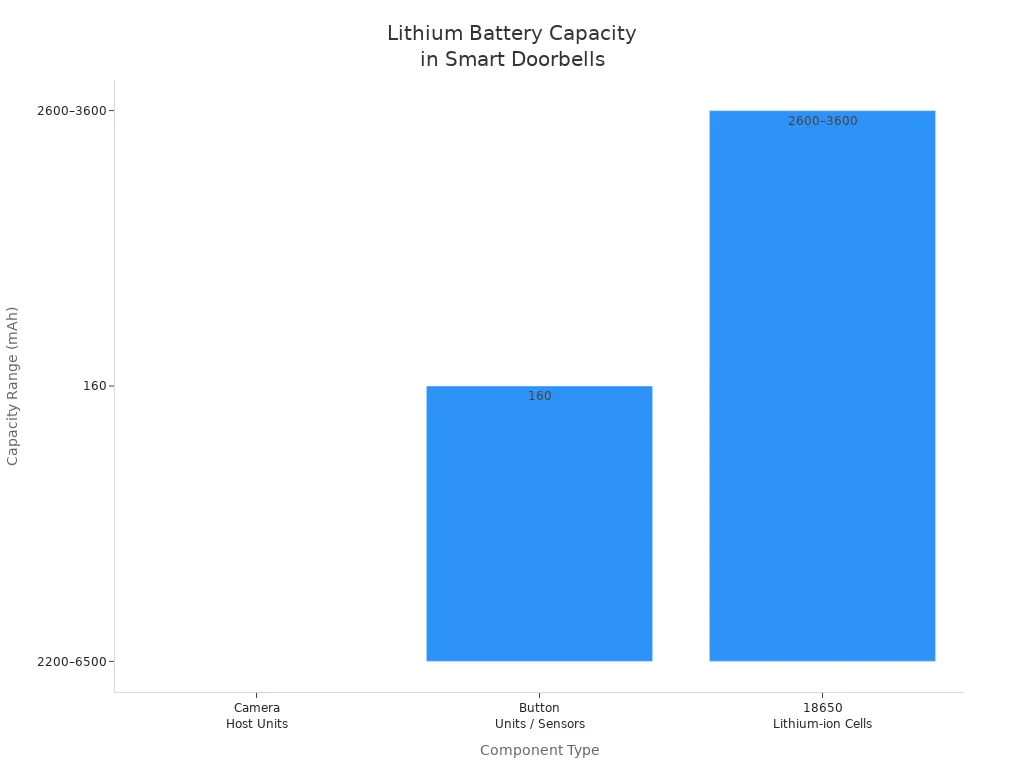
A higher battery capacity means longer battery life and fewer recharges. For example, a 6500mAh rechargeable battery can support multi-month runtimes under moderate use. However, you must balance capacity with physical size. Larger batteries may not fit in your device’s battery compartment. Always measure the available space before purchasing.
Factors to consider when choosing doorbell batteries include:
Usage frequency: More motion events or live views drain power faster.
Environmental conditions: Cold weather reduces battery life.
Wi-fi signal strength: Weak signals increase power consumption.
Note: Beware of fake capacity claims from low-quality brands. Always choose high-quality doorbell batteries from reputable manufacturers to ensure reliable power and long battery life.
1.3 Cell Type and Size
You will encounter several types of doorbell batteries, each with unique advantages. The two most common chemistries are lithium-ion (Li-ion) and lithium-polymer (Li-Po). The table below compares their key features:
Aspect | Li-ion Batteries | Li-Po Batteries |
|---|---|---|
Design | Rigid metal casing, limited shape flexibility | Flexible pouch design, adaptable to slim forms |
Energy Density | Higher, suitable for longer runtimes | Slightly lower |
Lifecycle | 300–500 cycles, more durable | Shorter, fewer charge cycles |
Safety | Robust enclosure, less prone to swelling | More vulnerable to punctures and swelling |
Heat Management | Retains more heat | Better heat dissipation |
Cost | More cost-effective | Higher cost |
Voltage Stability | May drop under high load | Stable output under load |
For most smart doorbells, Li-Po batteries offer better fit and heat management, especially in compact or uniquely shaped battery compartments. Li-ion batteries provide longer cycle life and durability, making them ideal for high-activity environments. Always select the cell type that matches your device’s original design and your operational needs.
Tip: If your doorbell uses a lithium-polymer battery, choose a Li-Po replacement for optimal fit and performance.
1.4 Interface and Fit
Proper fit and connection ensure your doorbell battery delivers stable power and supports all device functions. You should:
Measure the original battery’s length, width, and height with precision.
Check the connector type: Is it a metal tab, spring pin, or plug? The number, spacing, and polarity must match exactly.
Examine the interface: Some batteries use ribbon cables or special connectors. Take clear photos of the original battery and connector to confirm compatibility with the seller.
A mismatched interface or incorrect size can prevent your doorbell from receiving power, disrupt wi-fi connectivity, or even damage the device. Always verify these details before making a purchase.
Note: Investing time in precise measurement and connector matching helps you avoid installation issues and ensures uninterrupted home security.
Part 2: Doorbell Battery Quality and Safety
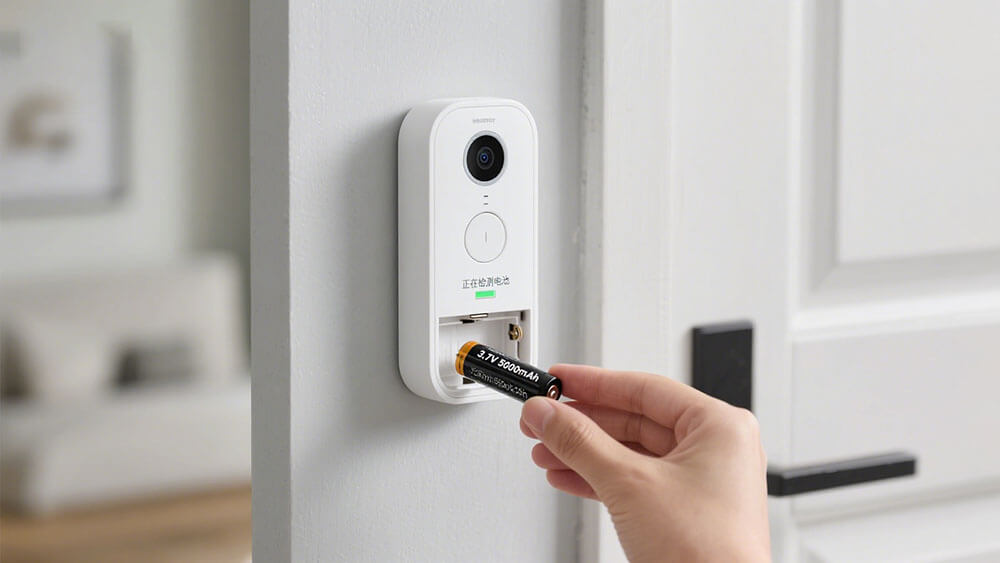
2.1 Protection Circuit and Certifications
You must prioritize safety when selecting a doorbell battery for your smart security system. Modern lithium batteries feature advanced protection circuits that safeguard your device and property. These circuits include overcharging protection, short-circuit prevention, high-temperature monitoring, and surge suppression. Manufacturers integrate fire-resistant construction and use components such as fuses, TVS diodes, and thermal sensors to prevent electrical faults and environmental damage.
Essential protection circuits in high-quality doorbell batteries:
Overcurrent protection
Voltage transient suppression
Thermal sensing
Overcharging protection
Short-circuit protection
High-temperature protection
Surge protection
These features ensure your doorbell battery operates safely and reliably, reducing the risk of fire hazards and device failure. You should always verify that the battery complies with international safety standards. The most recognized certifications include:
UL 1642 (individual lithium cells)
UL 2054 (battery packs)
IEC 62133 (portable sealed secondary cells)
UN38.3 (transportation safety)
CE (European Union compliance)
PSE (Japan)
KC (South Korea)
Tip: Always check for certification marks on the packaging or product description. Certified batteries guarantee safety, reliability, and legal market access.
2.2 Brand and Reliability
Brand reputation plays a critical role in the performance and longevity of your doorbell battery. Leading brands invest in research, quality control, and customer support, resulting in superior battery life and device integration. You should compare consumer reviews and reliability ratings before making a purchase.
Brand | Battery Life (Days) | Video Quality (Day/Night) | Motion Detection Reliability | Two-Way Talk Quality | App & Smart Assistant Features |
|---|---|---|---|---|---|
Nest | 33-35 | Best daytime and night | Best overall | Clear, low delay | Free intelligent alerts, strong Google/Alexa integration |
Ring | 50-58 | Midlevel | 3rd place | Clear, low delay | Removable battery pack, good app features, Alexa integration |
Eufy | 60-71 | 3rd place daytime | Reliable, dual cameras | Usable | Strong battery life, good motion detection, moderate app features |
Blink | 131 | Poor vertical FOV | 2nd place | Poor | Exceptional battery longevity, limited features |
360 | 83 | Lower night quality | Worst | Poor | Privacy zones, weaker overall performance |
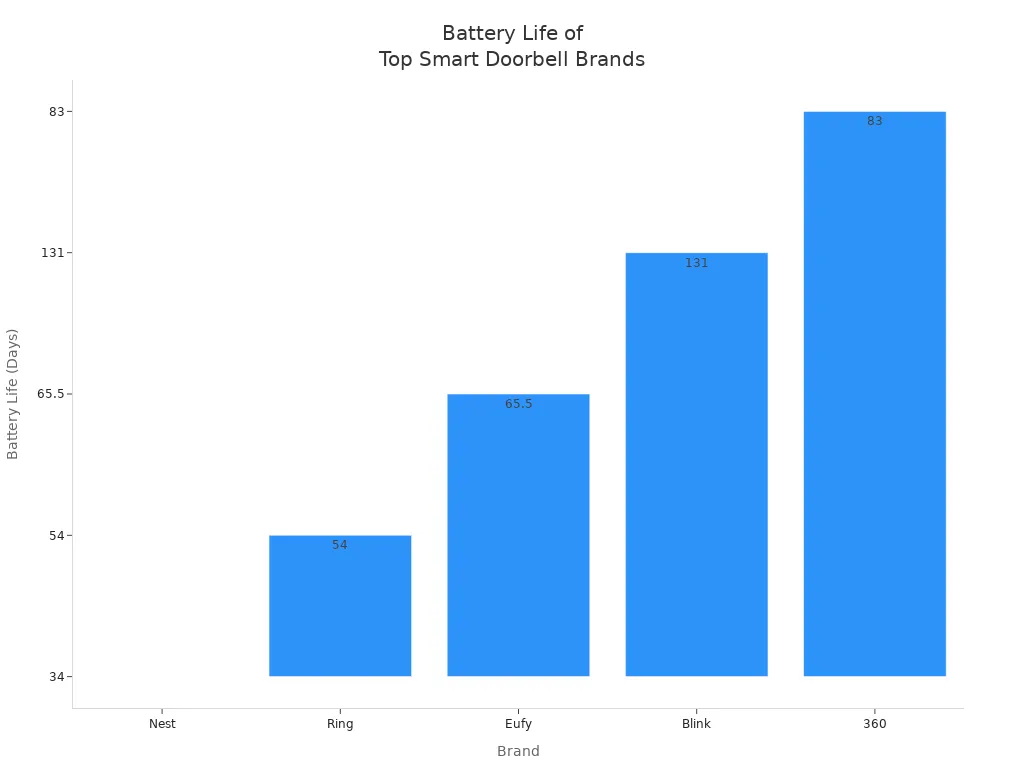
You will notice that high-quality doorbell batteries from reputable brands deliver longer battery life and more reliable operation. Investing in a trusted brand reduces the risk of device downtime and ensures consistent performance in security applications.
Note: Avoid low-cost, unbranded batteries. These often lack essential protections and certifications, which can compromise safety and reliability.
2.3 Weather Resistance
Outdoor smart doorbells face harsh environmental conditions. You must select a doorbell battery with strong weather resistance to maintain performance year-round. Extreme heat and freezing temperatures accelerate battery drain and reduce efficiency. Devices exposed to direct sunlight lose charge quickly, while cold weather can temporarily disable charging and lower battery life.
Key factors for weather resistance:
Optimal operating temperature: 75°F (25°C)
Functional range: -4°F to 122°F (-20°C to 50°C)
Cold weather reduces battery life and disables charging below freezing
Hot weather causes permanent degradation and device shutdowns
Shielding devices from snow, ice, and direct sun extends battery life
Alert: Install your smart doorbell in a shaded or sheltered location. Protect the device from direct sunlight and extreme temperatures to maximize battery life and maintain reliable operation.
2.4 Cycle Life and Maintenance
Cycle life measures how many times you can recharge a doorbell battery before its capacity drops below 80%. High-quality doorbell batteries offer 300 to 500 charge/discharge cycles, supporting long-term use in security systems and infrastructure applications. You should follow best practices to extend battery life and minimize maintenance costs.
Recommended maintenance practices:
Use brand-name batteries recommended by the manufacturer.
Enable only necessary features to reduce power consumption.
Maintain proper device alignment and cleanliness.
Inspect installation regularly to avoid extra power drain.
Monitor battery levels and replace batteries before full depletion.
Protect the device from extreme temperatures.
Keep firmware updated for battery optimization.
Maintain a stable network connection to prevent excessive drain.
Storage guidelines:
Store batteries at room temperature (50-77°F / 10-25°C)
Avoid direct sunlight, freezing, or extreme heat
Keep batteries in original packaging until use
Remove batteries from unused devices to prevent leakage
Clean contacts with a dry cloth for good connection
Tip: Always keep a spare rechargeable battery on hand. This ensures uninterrupted operation and quick replacement during maintenance or unexpected power loss.
When selecting a lithium battery for your smart doorbell, you should focus on these essentials:
Match voltage and compatibility with your device.
Choose lithium-ion for longevity and stable performance.
Prioritize reputable brands.
Ensure the battery tolerates your environment.
Consider long-term reliability and safety.
Reliable batteries keep your security systems running strong.
FAQ
1. What is the difference between lithium-ion, LiFePO4, and lithium-polymer (LiPo) battery packs for security systems?
Chemistry | Platform Voltage | Energy Density (Wh/kg) | Cycle Life (cycles) |
|---|---|---|---|
3.7V | 180–250 | 300–500 | |
3.2V | 90–140 | 2000+ | |
Lithium-polymer (LiPo) | 3.7V | 150–220 | 300–500 |
You should select based on your application’s energy, safety, and cycle life requirements.
2. How do you ensure lithium battery packs meet safety and compliance standards for infrastructure or industrial use?
You must verify certifications such as UL, CE, and RoHS. Large Power custom consultation offers guidance on compliant lithium battery pack solutions.
Can you customize lithium battery packs for Medical or Robotics applications?
Yes. Large Power provides custom lithium battery pack solutions for Medical and Robotics sectors. Contact our engineering team for tailored support.




